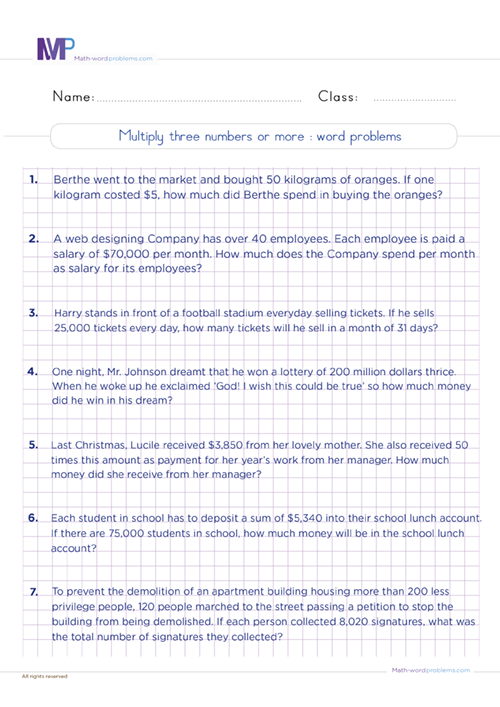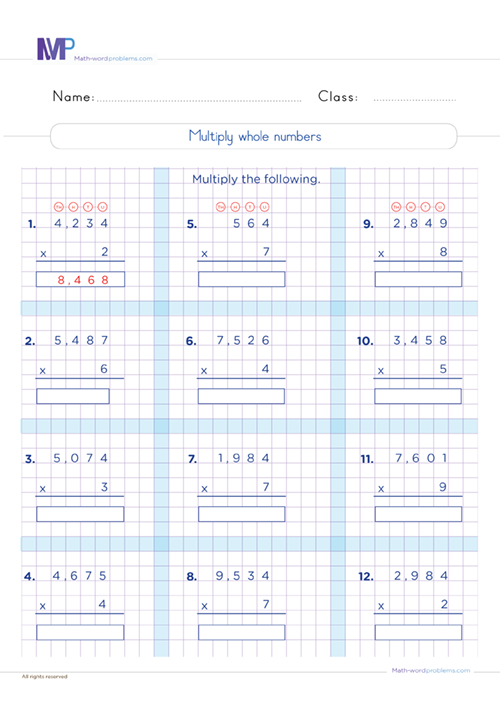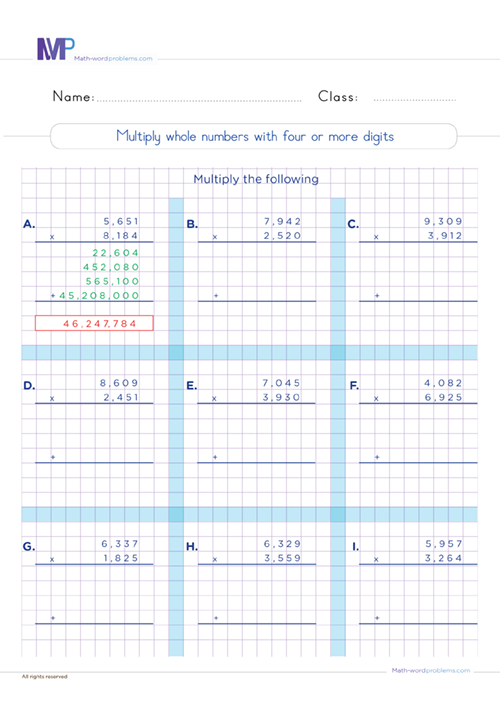 How to multiply numbers ending in zeros word problems
How to multiply numbers ending in zeros word problems

- INTRODUCTION
- Step1 Identify
- Step 2 STRATEGIZE
- Step 3 SET UP
- Step 4 PROVIDE A SOLUTION
- Step 5 CHECK YOUR WORK
Get more contents on this skill...
Learn how to multiply numbers ending in zeros word problems quickly using our fun methods and strategies. This method is very interesting and will help to overcome challenges kids face when multiplying larger digits ending in zeros in word problems.
The fact that math word problems use textual narratives or statements to describe word problems is already challenging enough for kids. However, with our fun strategy, your kids can develop unique problem-solving abilities and fluently interpret all word problems, no matter how complex they seem.
Another great advantage of this method is that it will help kids easily tackle and relate word problems to real-world situations, making them exceptional and skillful word problem-solvers.
Steps on how to solve multiplication of numbers ending in zeros word problems
Below here are simple steps on how to solve multiplications of numbers ending in zeros word problems. These steps will embed the sense of solving word problems following an orderly procedure in kids.
As we said earlier, our solving steps will greatly motivate kids to become skillful in solving complex word problems in a quick and enjoyable way. However, we'll carry you along as we solve the following real-life examples of multiplying numbers ending in zeros word problems
Step 1: IDENTIFY:
First and foremost, you must read the whole problem very carefully to identify important numbers, keywords in the word problem, and, in some cases, most notably, the problem's description.
Generally, in case you come across one of the following keywords in a word problem: - times, multiplied by, product, product of, factor, of, multiply, times, multiple, double, triple, groups, by, twice, area, equal groups, every, in all, total, increased by, as much, each, lots of, groups of, per, etc., then it implies that you have to perform a Multiplication Operation.
- ***One key Element for learners to understand is that they should not always rely on keywords alone. That is to say; the same keyword can have different meanings in different word problems.
- For this reason, we reiterate on the importance of reading the question very carefully to understand the situation that the word problem is describing, then figure out exactly which operation to use***
Step 2: STRATEGIZE:
Moving forward, ask yourself this question. "How am I going to go about this question?"
- From the keyword(s) in the word problem, you will know if you need to perform a Multiplication Operation or Not.
- It would be best not to only depend on keywords. Rather, try to understand the situation that the problem is describing.
- After knowing which operation you will perform, construct short expressions/sentences to represent the given word problem.
Step 3: SET UP:
At this point, write down a numerical expression or a mathematical equation representing the information in the word problem.
Step 4: PROVIDE A SOLUTION:
Following this, from step 3 above, multiply the numbers using regrouping or other multiplication methods like long multiplication, grid multiplication, and lattice method to determine the result. Most importantly, do not forget the unit of measurement, if any.
Step 5: CHECK YOUR WORK:
Finally, ask yourself this question. Does my answer make sense? If “YES”, you are done. If “NO”, go back to step 1 and start all over again.
Example on how to solve multiplication of whole numbers ending in zeros word problems
Step 1: To begin with, the important numbers here are $3,850 and 50. Also, the keyword(s) found in the word problem is "times."
Step 2: Then, how will you solve the problem? From the situation that the problem is describing and the keyword(s) found in the word problem calls for you to perform a multiplication operation.
Later, after knowing which operation you will perform, create short expressions/sentences to represent the given word problem.
- Amount of money she received from her mother = $3,850.
- Therefore, the amount of money she received from her manager = the amount of money she received from her mother × 50.
Step 3: Now, write down a numerical expression/ a mathematical equation to represent the bolded sentence in step 2 above:
$3,850 × 50 = ?
Step 4: Following this, multiply the numbers using regrouping or any other multiplication methods like long multiplication, grid multiplication, and lattice method to determine the result. Always remember to add the unit of measurement to your final answer, if any.
Using the long multiplication method and the rule of multiplying numbers ending in zeros (which is transfer all the zeros to one factor and then proceed to multiply as shown below), we have:-
So, she received $192,500 from her manager.
Step 5:On a final note, check out your work to know if it makes sense, i.e., by estimating the numbers and calculating mentally. If the answer is so close to the one you have, then your answer is correct but if the answer is not close to your answer, go back to step 1.





